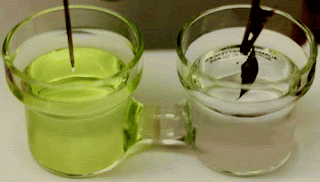 |
| Electrochemical cell with electrode plasma. (pubs.acs.org) |
"Plasmas formed at ambient conditions are normally sparks which are uncontrolled, unstable and destructive," said Mohan Sankaran, a chemical engineering professor and senior author of the paper. "We've developed a plasma source that is stable at atmospheric pressure and room temperature which allows us to study and control the transfer of electrons across the interface of a plasma and an electrolyte solution." Where a description of the research is now published in the online edition of the Journal of the American Chemical Society.
Electrochemical cell is made of two glass jars connected by a glass tube. Electrolyte solution made from potassium ferricyanide and potassium chloride.
For the cathode, argon gas was pumped through a stainless steel tube that was placed a short distance above the solution. A microplasma formed between the tube and the surface. The anode was a piece of silver/silver chloride.
When a current was passed through the plasma, electrons reduced ferricyanide to ferrocyanide. Monitoring with ultraviolet-visible spectrophotometry showed the solution was reduced at a relatively constant rate and that each ferrycyanide molecule was reduced to one ferrocyanide molecule. As the current was raised, the rate of reduction increased. And testing at both electrodes showed no current was lost.
There are two drawbacks of this technology. Only about one in 20 electrons transferred from the plasma was involved in the reduction reaction. They speculate the lost electrons were converting hydrogen in the water to hydrogen molecules, or that other reactions they were unable to monitor were taking place. They are setting up new tests to find out. Additionally, the power needed to form the plasma and induce the electrochemical reactions was substantially higher than that required to induce the reaction with metal cathodes.
Source: sciencedaily and http://pubs.acs.org/doi/abs/10.1021/ja207547b
Source: sciencedaily and http://pubs.acs.org/doi/abs/10.1021/ja207547b
Post a Comment